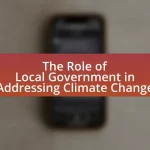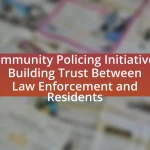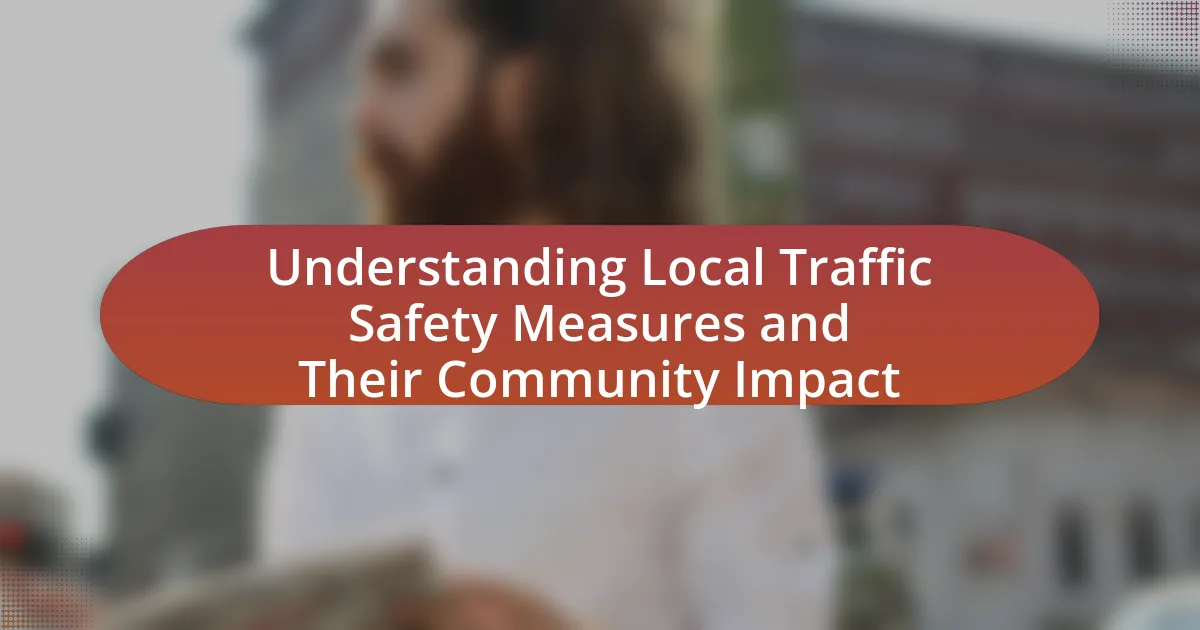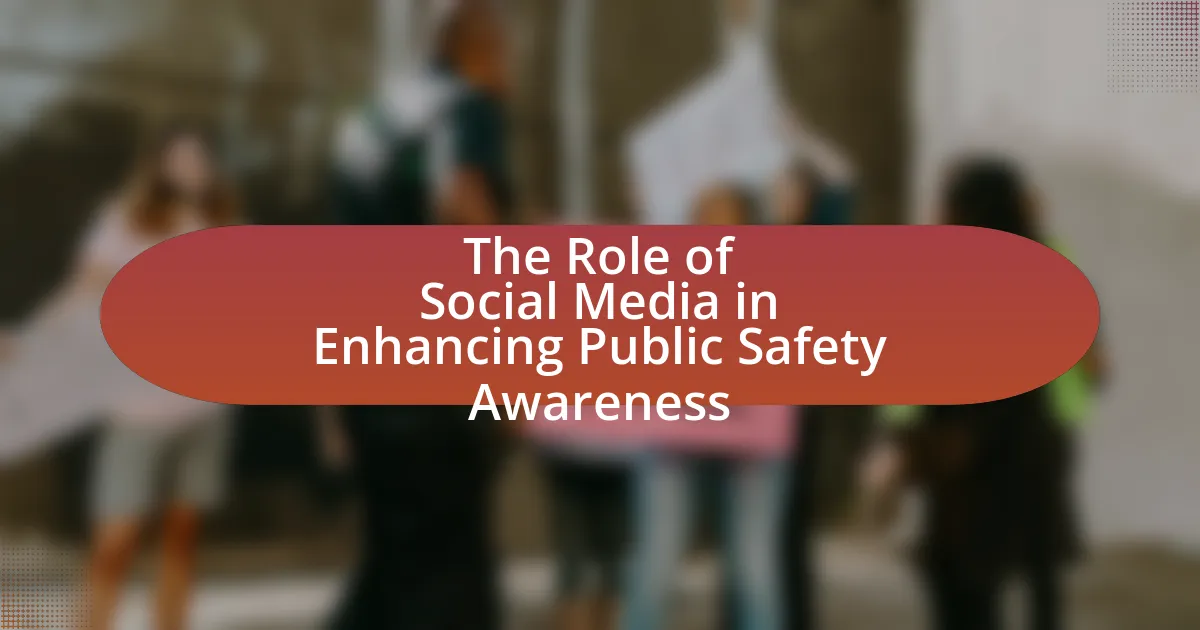Emergency preparedness is a critical process for local governments, involving the planning and organization of resources to effectively respond to emergencies and disasters. This article outlines the importance of emergency preparedness for community safety and resilience, detailing key components of effective preparedness plans, the role of community involvement, and the types of emergencies that local governments should prepare for. It also discusses strategies for educating citizens, including the use of workshops, social media, and partnerships, while addressing challenges such as financial constraints and misinformation. Additionally, the article emphasizes the need for ongoing support and resources to foster a culture of preparedness within communities.
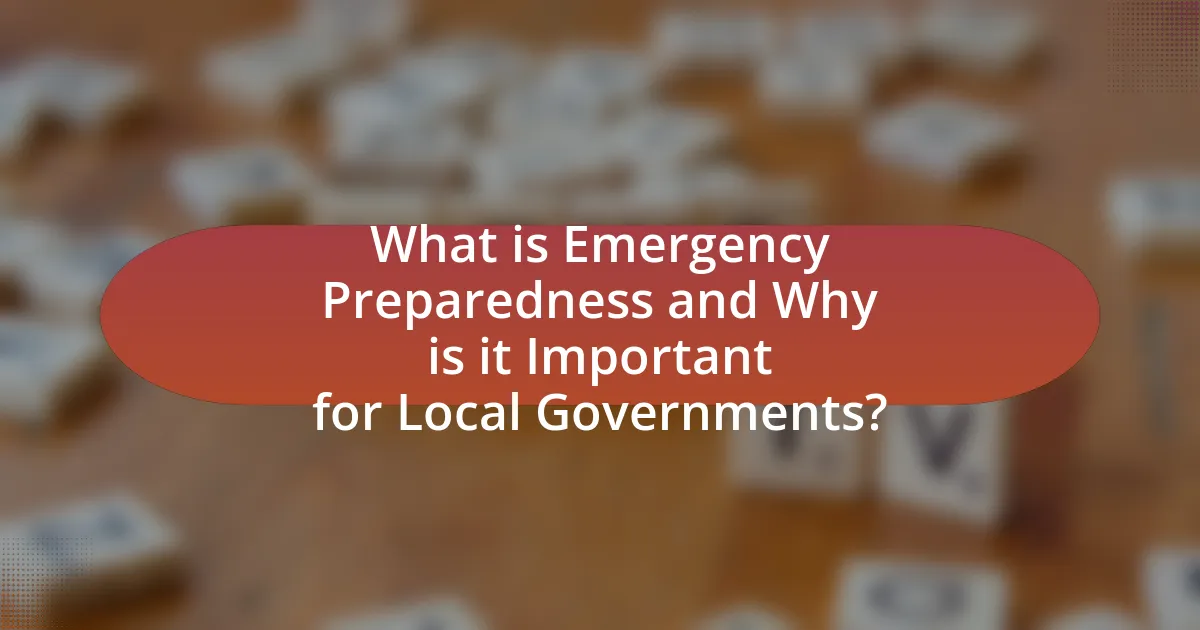
What is Emergency Preparedness and Why is it Important for Local Governments?
Emergency preparedness is the process by which local governments plan and organize resources to effectively respond to emergencies and disasters. This is crucial for local governments because it ensures the safety and resilience of communities during crises, minimizing loss of life and property. According to the Federal Emergency Management Agency (FEMA), communities that engage in emergency preparedness can reduce the impact of disasters by up to 50%. Preparedness activities include training, resource allocation, and public education, which collectively enhance a community’s ability to respond swiftly and efficiently to emergencies.
How do local governments define emergency preparedness?
Local governments define emergency preparedness as the process of planning, organizing, and equipping communities to effectively respond to and recover from emergencies and disasters. This definition encompasses the development of emergency plans, training for first responders, and public education initiatives aimed at enhancing community resilience. For instance, the Federal Emergency Management Agency (FEMA) emphasizes that local governments must engage in risk assessment, resource allocation, and collaboration with various stakeholders to ensure comprehensive preparedness strategies are in place.
What are the key components of an effective emergency preparedness plan?
An effective emergency preparedness plan includes risk assessment, resource allocation, communication strategies, training and exercises, and recovery planning. Risk assessment identifies potential hazards and vulnerabilities, enabling targeted preparedness efforts. Resource allocation ensures that necessary supplies and personnel are available during emergencies. Communication strategies facilitate timely information dissemination to the public and stakeholders, which is crucial for effective response. Training and exercises prepare individuals and organizations to respond efficiently, while recovery planning outlines steps for restoring normalcy post-emergency. These components are essential for enhancing community resilience and ensuring a coordinated response during crises.
Why is community involvement crucial in emergency preparedness?
Community involvement is crucial in emergency preparedness because it enhances resilience and ensures effective response during crises. Engaged communities are better equipped to identify local risks, develop tailored emergency plans, and mobilize resources quickly. Research indicates that communities with active participation in preparedness initiatives experience reduced disaster impacts; for instance, the Federal Emergency Management Agency (FEMA) reports that community-based programs significantly improve recovery times and resource allocation during emergencies. Thus, community involvement directly correlates with improved outcomes in emergency situations.
What types of emergencies should local governments prepare for?
Local governments should prepare for natural disasters, public health emergencies, technological incidents, and civil disturbances. Natural disasters include events like hurricanes, floods, and earthquakes, which can cause significant damage and require coordinated response efforts. Public health emergencies, such as pandemics or disease outbreaks, necessitate rapid communication and resource allocation to protect community health. Technological incidents, including cyberattacks or hazardous material spills, pose risks to infrastructure and safety, requiring specialized response plans. Civil disturbances, such as protests or riots, demand preparedness for maintaining public order and safety. These categories are supported by frameworks like the Federal Emergency Management Agency’s (FEMA) guidelines, which emphasize the importance of comprehensive emergency management planning.
How do natural disasters impact local communities?
Natural disasters significantly disrupt local communities by causing loss of life, destruction of property, and economic instability. For instance, the 2010 earthquake in Haiti resulted in over 200,000 deaths and left millions homeless, illustrating the immediate and devastating effects on community structures and social networks. Additionally, natural disasters can lead to long-term psychological impacts, as seen in survivors of Hurricane Katrina, where studies indicated high rates of PTSD among affected populations. The economic repercussions are also profound; the National Oceanic and Atmospheric Administration reported that the U.S. experienced over $1 trillion in damages from natural disasters between 1980 and 2020, highlighting the financial strain on local governments and communities. These factors underscore the critical need for effective emergency preparedness education by local governments to mitigate the impacts of such disasters.
What role do public health emergencies play in local preparedness efforts?
Public health emergencies significantly enhance local preparedness efforts by highlighting vulnerabilities and prompting the development of response plans. These emergencies, such as pandemics or natural disasters, serve as critical catalysts for local governments to assess their existing health infrastructure, identify gaps, and implement training programs for emergency responders. For instance, the COVID-19 pandemic revealed the need for improved communication strategies and resource allocation, leading to the establishment of more robust public health frameworks. This proactive approach ensures that communities are better equipped to handle future crises, ultimately saving lives and minimizing disruption.
How can local governments assess the current state of emergency preparedness?
Local governments can assess the current state of emergency preparedness by conducting comprehensive evaluations that include surveys, drills, and reviews of existing emergency plans. These assessments typically involve gathering data on community resources, response capabilities, and public awareness levels regarding emergency procedures. For instance, the Federal Emergency Management Agency (FEMA) recommends that local governments utilize the Community Rating System to evaluate their preparedness efforts, which includes metrics such as training participation rates and the effectiveness of communication strategies. Additionally, analyzing past emergency responses can provide insights into strengths and weaknesses, allowing for targeted improvements in future preparedness initiatives.
What tools and methods are available for evaluating preparedness levels?
Tools and methods available for evaluating preparedness levels include surveys, drills, and assessments. Surveys, such as the Community Preparedness Survey developed by FEMA, gather data on citizens’ knowledge and readiness. Drills simulate emergency scenarios, allowing local governments to assess response capabilities in real-time. Assessments, like the Emergency Management Accreditation Program (EMAP), provide a framework for evaluating preparedness against established standards. These methods collectively enable local governments to identify gaps in preparedness and enhance community resilience.
How can data collection improve emergency preparedness strategies?
Data collection can significantly enhance emergency preparedness strategies by providing accurate, real-time information that informs decision-making and resource allocation. For instance, local governments can gather data on population density, infrastructure vulnerabilities, and historical disaster patterns to identify high-risk areas and prioritize emergency response efforts. Research from the National Institute of Standards and Technology indicates that communities utilizing data-driven approaches can reduce response times by up to 30%, thereby improving overall resilience during emergencies. This evidence underscores the critical role of data collection in shaping effective preparedness plans that are responsive to the specific needs of communities.
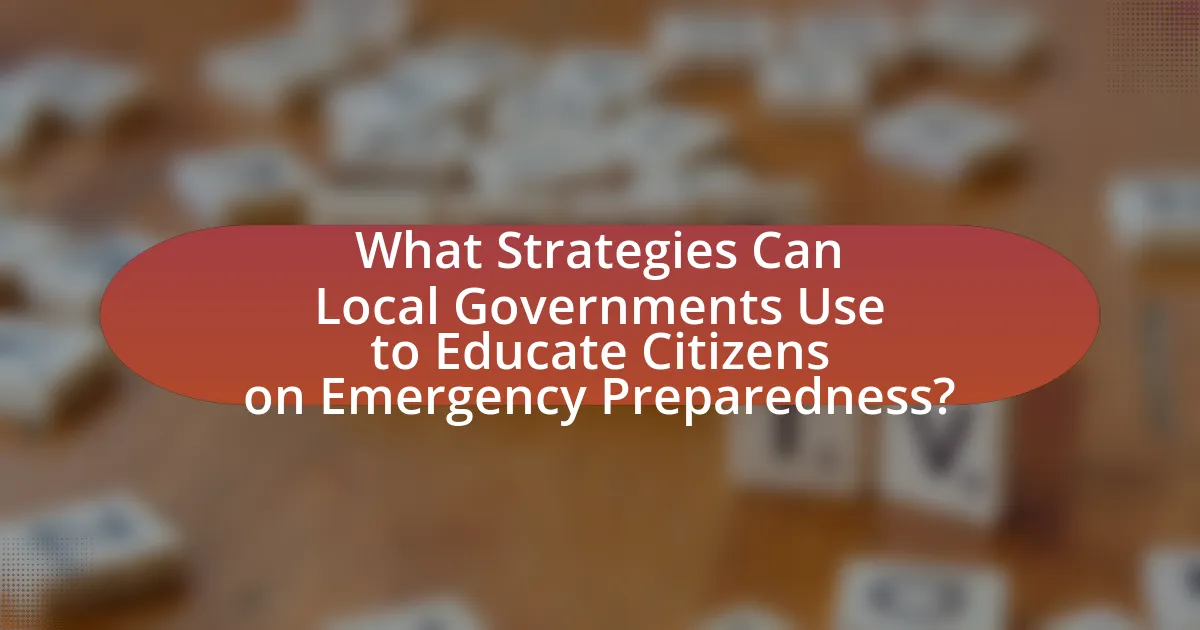
What Strategies Can Local Governments Use to Educate Citizens on Emergency Preparedness?
Local governments can educate citizens on emergency preparedness through community workshops, social media campaigns, and partnerships with local organizations. Community workshops provide hands-on training and information dissemination, allowing residents to learn about emergency plans, evacuation routes, and safety protocols. Social media campaigns can reach a wider audience quickly, sharing tips, resources, and alerts in real-time, which is crucial during emergencies. Partnerships with local organizations, such as schools and nonprofits, can enhance outreach efforts by leveraging existing networks to distribute educational materials and host events. These strategies have been shown to increase community awareness and preparedness, as evidenced by studies indicating that informed citizens are more likely to take proactive measures during emergencies.
How can local governments effectively communicate emergency preparedness information?
Local governments can effectively communicate emergency preparedness information by utilizing multiple channels such as social media, community workshops, and local media outlets. These methods ensure that information reaches diverse populations, enhancing public awareness and engagement. For instance, a study by the Federal Emergency Management Agency (FEMA) found that communities that employed a multi-channel approach saw a 30% increase in citizen preparedness levels. Additionally, local governments can collaborate with community organizations to disseminate tailored information, ensuring that it is culturally relevant and accessible. This strategy not only improves understanding but also fosters trust between the government and the community, which is crucial during emergencies.
What channels are most effective for reaching diverse community members?
Social media platforms, community radio, and local events are the most effective channels for reaching diverse community members. Social media allows for targeted outreach and engagement, as platforms like Facebook and Instagram can be tailored to specific demographics, facilitating communication with various cultural groups. Community radio serves as an accessible medium, particularly for those who may not have internet access, providing localized information in multiple languages. Local events, such as town hall meetings or workshops, foster direct interaction and trust, enabling local governments to educate citizens on emergency preparedness in a culturally relevant manner. These channels have been shown to enhance participation and information dissemination among diverse populations, as evidenced by studies indicating that community-based approaches significantly improve engagement in public health initiatives.
How can social media be leveraged for emergency preparedness education?
Social media can be leveraged for emergency preparedness education by providing real-time information, engaging communities, and disseminating educational content. Local governments can utilize platforms like Twitter, Facebook, and Instagram to share alerts about emergencies, safety tips, and preparedness resources, reaching a broad audience quickly. For instance, during natural disasters, agencies can post updates on evacuation routes and shelter locations, which can significantly enhance public safety. Research indicates that 70% of adults in the U.S. use social media, making it an effective channel for outreach and engagement in emergency preparedness initiatives.
What role do community workshops and training sessions play in education?
Community workshops and training sessions play a crucial role in education by providing hands-on learning experiences that enhance knowledge and skills related to emergency preparedness. These interactive sessions allow participants to engage directly with experts, fostering a deeper understanding of emergency protocols and response strategies. Research indicates that communities that participate in such workshops demonstrate improved readiness and resilience during crises, as evidenced by a study from the Federal Emergency Management Agency (FEMA) which found that trained individuals are 60% more likely to take appropriate action during emergencies. Thus, community workshops and training sessions are essential for equipping citizens with the necessary tools and knowledge to effectively respond to emergencies.
How can local governments design engaging and informative workshops?
Local governments can design engaging and informative workshops by incorporating interactive elements, utilizing expert speakers, and tailoring content to community needs. Interactive elements, such as hands-on activities and group discussions, enhance participant engagement and retention of information. Inviting expert speakers, such as emergency management professionals, provides credible insights and real-world experiences that enrich the learning experience. Additionally, conducting surveys or focus groups prior to the workshops allows local governments to identify specific community concerns and interests, ensuring that the content is relevant and addresses the needs of the citizens. This approach not only fosters a more informed public but also encourages active participation in emergency preparedness initiatives.
What topics should be covered in emergency preparedness training sessions?
Emergency preparedness training sessions should cover topics such as risk assessment, emergency response plans, communication strategies, first aid and medical assistance, evacuation procedures, and disaster recovery. These topics are essential for equipping individuals with the knowledge and skills necessary to effectively respond to emergencies. For instance, understanding risk assessment helps participants identify potential hazards in their community, while learning about evacuation procedures ensures they know how to safely exit a building during a crisis. Additionally, training in first aid can significantly improve survival rates in emergencies, as evidenced by studies showing that immediate medical assistance can reduce fatalities.
How can partnerships enhance educational efforts in emergency preparedness?
Partnerships can enhance educational efforts in emergency preparedness by leveraging diverse resources, expertise, and networks to create comprehensive training programs. Collaborative efforts between local governments, non-profit organizations, and community groups can lead to the development of tailored educational materials that address specific community needs, ensuring that information is relevant and accessible. For instance, a study by the Federal Emergency Management Agency (FEMA) highlights that communities with strong partnerships experience improved participation in preparedness training, as these collaborations facilitate outreach and engagement through established trust and communication channels.
What organizations can local governments collaborate with for better outreach?
Local governments can collaborate with non-profit organizations, community-based organizations, and educational institutions for better outreach. Non-profit organizations, such as the American Red Cross, provide resources and training for emergency preparedness, enhancing community awareness. Community-based organizations often have established trust and communication channels within local populations, facilitating effective information dissemination. Educational institutions can offer platforms for workshops and training sessions, engaging students and families in preparedness initiatives. These collaborations leverage existing networks and expertise, ensuring that outreach efforts are more effective and widely received.
How can schools be involved in promoting emergency preparedness education?
Schools can promote emergency preparedness education by integrating it into their curriculum and conducting regular drills. By incorporating lessons on disaster response, first aid, and safety protocols into subjects like health and social studies, schools can ensure that students understand the importance of being prepared. Additionally, schools can organize community workshops and collaborate with local emergency services to provide hands-on training and resources. Research indicates that educational programs significantly enhance students’ knowledge and readiness for emergencies, as evidenced by a study published in the Journal of School Health, which found that schools implementing emergency preparedness curricula saw a 30% increase in student awareness and preparedness levels.
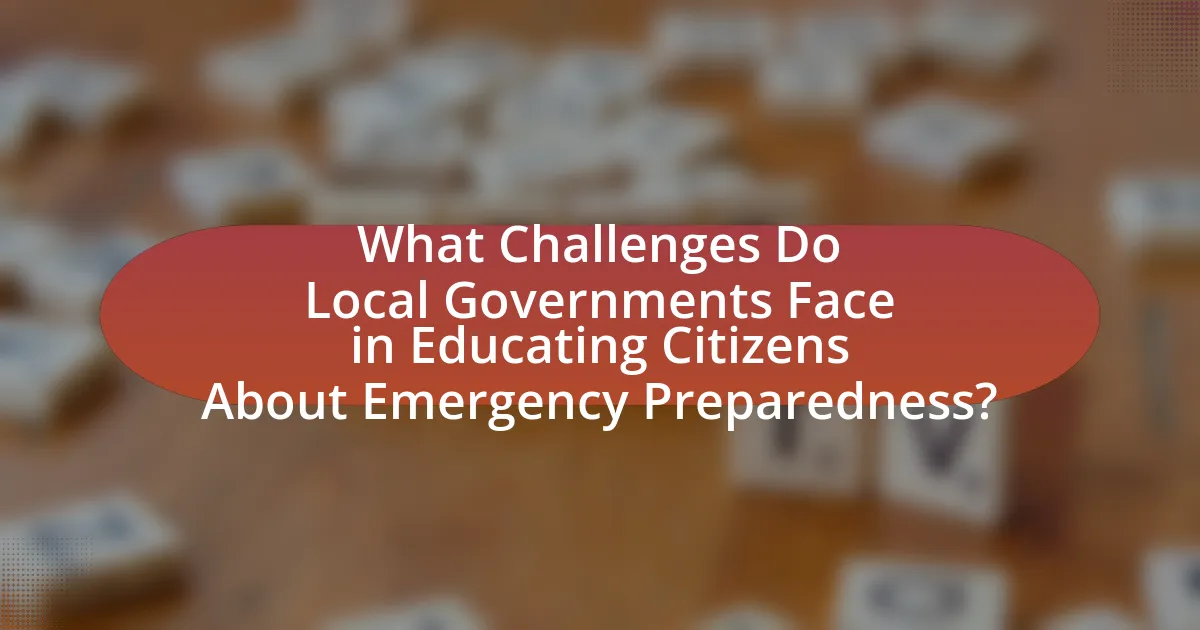
What Challenges Do Local Governments Face in Educating Citizens About Emergency Preparedness?
Local governments face significant challenges in educating citizens about emergency preparedness, primarily due to limited resources, varying levels of public engagement, and misinformation. Limited budgets restrict the ability to conduct comprehensive outreach programs, which are essential for effective education. Additionally, citizens often exhibit varying degrees of interest and engagement, making it difficult to reach all demographics effectively. Misinformation, particularly through social media, can further complicate efforts, as citizens may rely on inaccurate sources for information about emergency preparedness. These factors collectively hinder local governments’ ability to ensure that all citizens are adequately informed and prepared for emergencies.
What barriers exist in reaching all segments of the community?
Barriers in reaching all segments of the community include language differences, socioeconomic disparities, and lack of access to technology. Language differences hinder communication with non-native speakers, making it difficult for local governments to convey emergency preparedness information effectively. Socioeconomic disparities can limit access to resources and information, as lower-income individuals may lack transportation or time to engage with educational programs. Additionally, lack of access to technology, such as the internet or smartphones, prevents certain community members from receiving timely updates and resources related to emergency preparedness. These barriers collectively impede the ability of local governments to educate all citizens effectively.
How can language and cultural differences impact education efforts?
Language and cultural differences can significantly impact education efforts by creating barriers to effective communication and understanding. When local governments attempt to educate citizens about emergency preparedness, language differences may prevent non-native speakers from fully grasping critical information, leading to confusion and inadequate responses during emergencies. For instance, a study by the National Center for Disaster Preparedness found that communities with high percentages of non-English speakers often experience lower levels of preparedness due to a lack of accessible information in their native languages. Additionally, cultural differences can influence how individuals perceive risks and respond to emergency messages, as cultural beliefs and practices shape attitudes toward authority and compliance. This underscores the necessity for local governments to tailor educational materials to accommodate diverse linguistic and cultural backgrounds, ensuring that all citizens receive clear, relevant, and actionable information during emergencies.
What strategies can overcome financial constraints in educational programs?
Collaborative funding models can effectively overcome financial constraints in educational programs. Local governments can partner with non-profit organizations, businesses, and community stakeholders to pool resources and share costs. For instance, the Federal Emergency Management Agency (FEMA) offers grants that local governments can leverage to enhance educational initiatives on emergency preparedness. Additionally, implementing cost-sharing agreements with local businesses can provide financial support while fostering community engagement. Research indicates that collaborative funding not only alleviates financial burdens but also enhances program sustainability and reach, as seen in successful community-based educational programs across various regions.
How can local governments measure the effectiveness of their educational initiatives?
Local governments can measure the effectiveness of their educational initiatives by utilizing quantitative metrics such as pre- and post-initiative surveys, attendance rates, and engagement levels. These metrics provide concrete data on knowledge retention and behavioral changes among citizens. For instance, a study by the Federal Emergency Management Agency (FEMA) indicated that communities with structured educational programs saw a 30% increase in emergency preparedness awareness, as measured through follow-up surveys. Additionally, analyzing participation rates in drills and workshops can further quantify the impact of educational efforts, demonstrating how well citizens are absorbing and applying the information provided.
What metrics should be used to evaluate citizen engagement and knowledge retention?
Metrics to evaluate citizen engagement and knowledge retention include participation rates, feedback surveys, knowledge assessments, and social media interactions. Participation rates measure the number of citizens involved in educational programs or events, indicating engagement levels. Feedback surveys assess citizen satisfaction and perceived value of the information provided, which reflects knowledge retention. Knowledge assessments, such as quizzes or tests, directly evaluate the understanding of emergency preparedness concepts. Social media interactions, including shares, comments, and likes, provide insights into the reach and impact of educational content. These metrics collectively offer a comprehensive view of how effectively local governments educate citizens on emergency preparedness.
How can feedback from the community improve future educational efforts?
Feedback from the community can significantly enhance future educational efforts by providing insights into the specific needs and preferences of the population. When local governments gather input from citizens, they can identify gaps in knowledge, assess the effectiveness of current educational programs, and tailor future initiatives to address these areas. For instance, a study by the National Institute of Standards and Technology found that community engagement in emergency preparedness education led to a 30% increase in participation rates in training programs. This demonstrates that incorporating community feedback not only aligns educational content with the audience’s needs but also fosters greater involvement and retention of information.
What are some best practices for local governments in emergency preparedness education?
Local governments should implement community engagement, regular training, and accessible resources as best practices for emergency preparedness education. Community engagement involves organizing workshops and drills that actively involve residents, enhancing their understanding of emergency protocols. Regular training for both staff and citizens ensures that everyone is familiar with emergency procedures, which is crucial during actual events. Providing accessible resources, such as multilingual materials and online platforms, ensures that information reaches diverse populations, thereby increasing overall preparedness. These practices are supported by studies indicating that informed communities respond more effectively during emergencies, ultimately reducing risks and improving safety outcomes.
How can local governments create a culture of preparedness within the community?
Local governments can create a culture of preparedness within the community by implementing comprehensive education and training programs focused on emergency readiness. These programs can include workshops, simulations, and community drills that engage residents in practical preparedness activities. For instance, the Federal Emergency Management Agency (FEMA) emphasizes the importance of community engagement through initiatives like the Community Rating System, which encourages local governments to promote preparedness education. Additionally, local governments can collaborate with schools, businesses, and non-profit organizations to disseminate information and resources, ensuring that all community members have access to vital preparedness knowledge. This multifaceted approach not only raises awareness but also fosters a proactive mindset among residents, ultimately enhancing community resilience in the face of emergencies.
What ongoing support and resources can be provided to citizens post-education?
Ongoing support and resources that can be provided to citizens post-education include access to community training programs, emergency response drills, and informational resources such as online portals and hotlines. Community training programs, often organized by local governments, equip citizens with skills in first aid, disaster response, and emergency management, enhancing their preparedness. Emergency response drills simulate real-life scenarios, allowing citizens to practice their skills and improve coordination with local emergency services. Additionally, online portals and hotlines offer continuous access to updated information, resources, and guidance on emergency preparedness, ensuring citizens remain informed and ready to act in crises. These initiatives are essential for fostering a culture of preparedness and resilience within communities.

